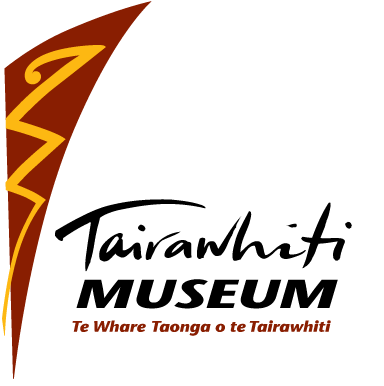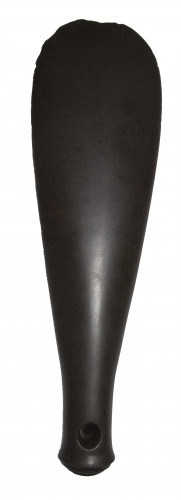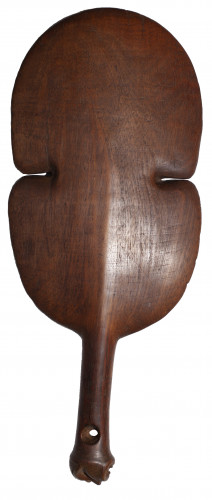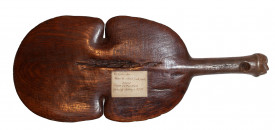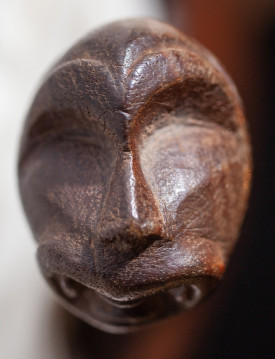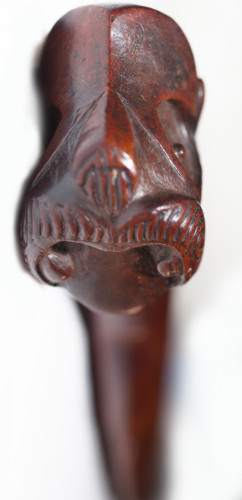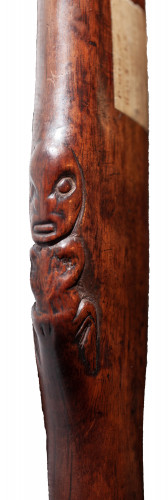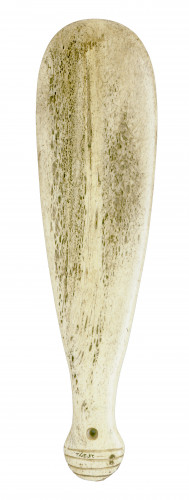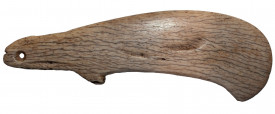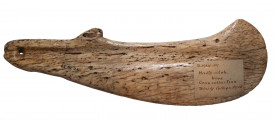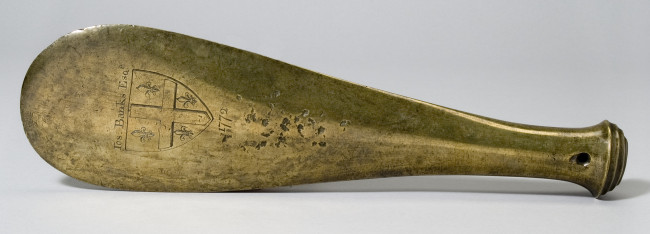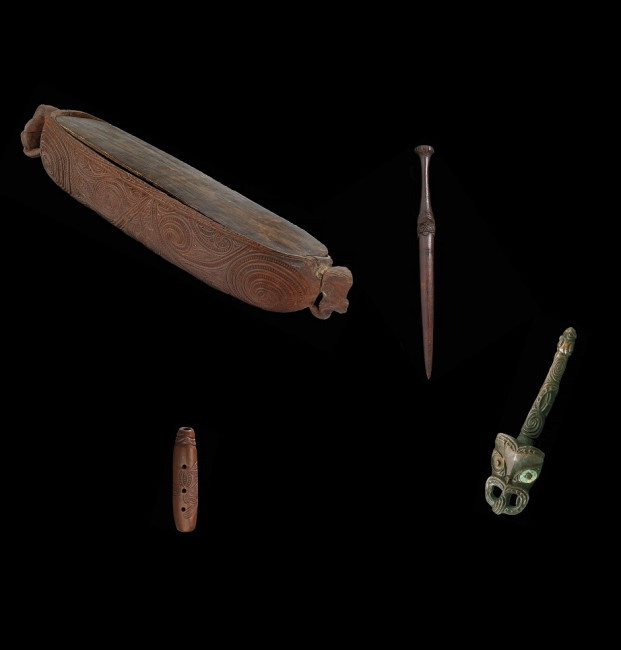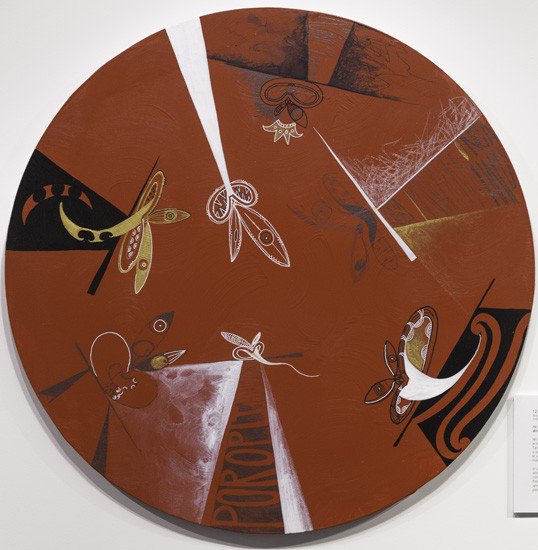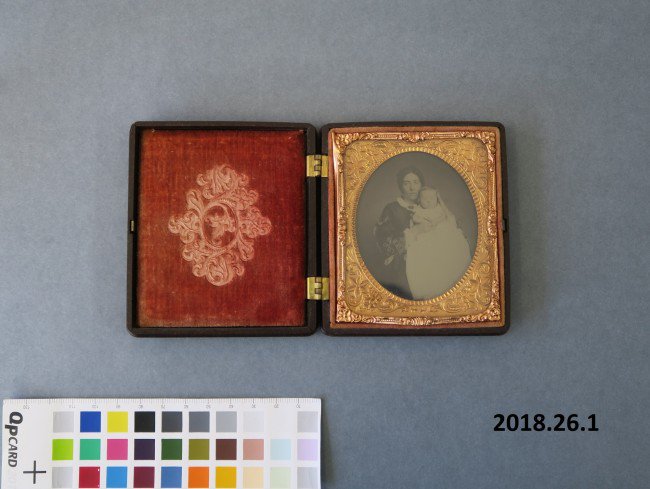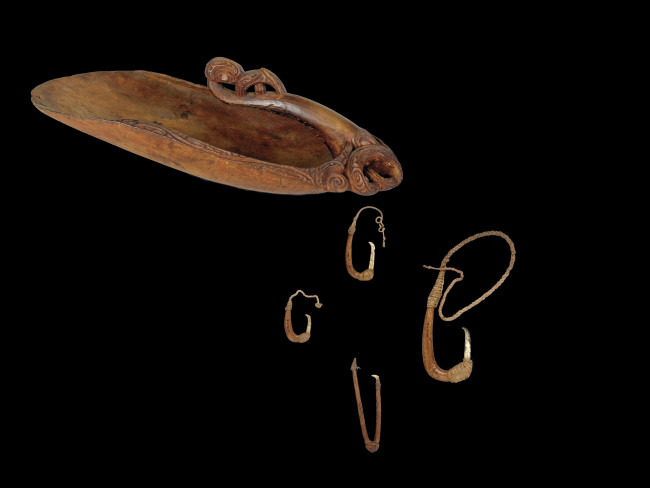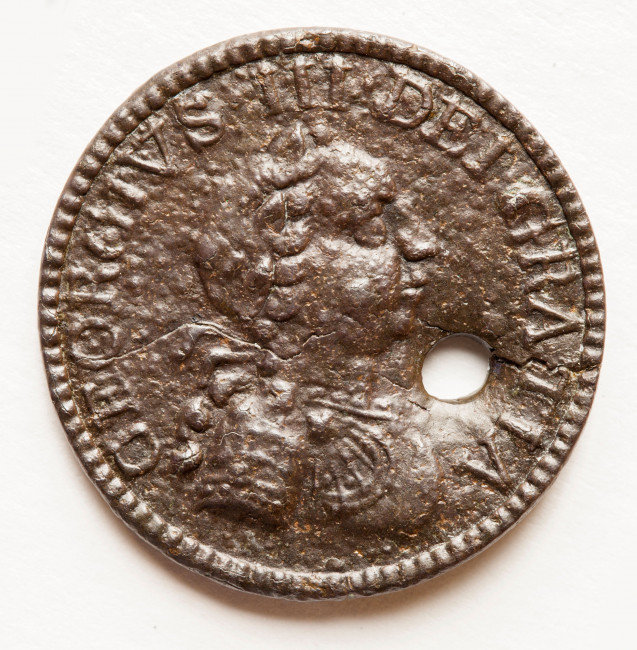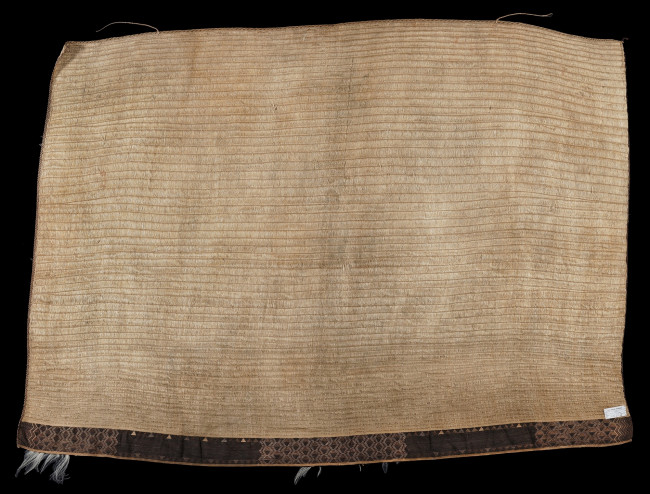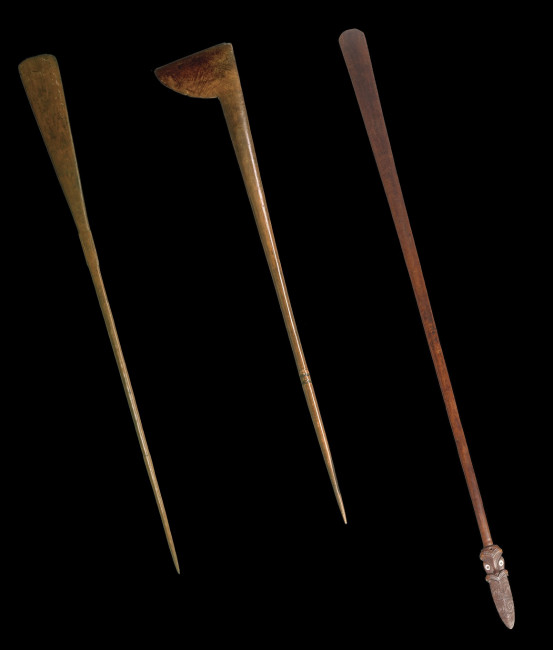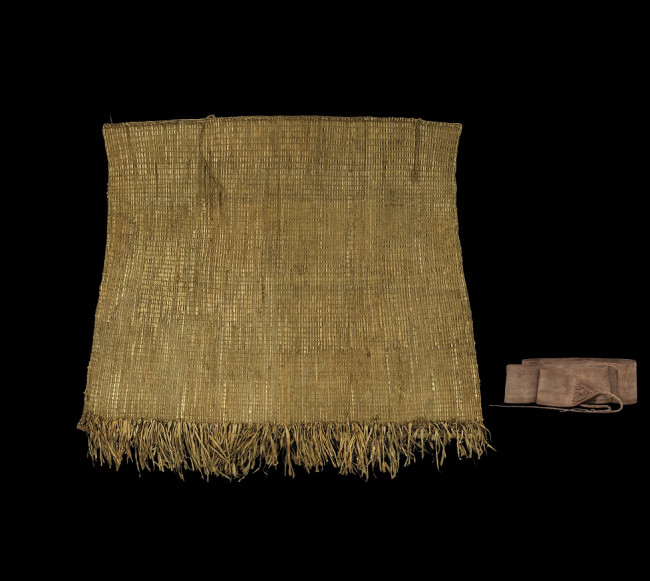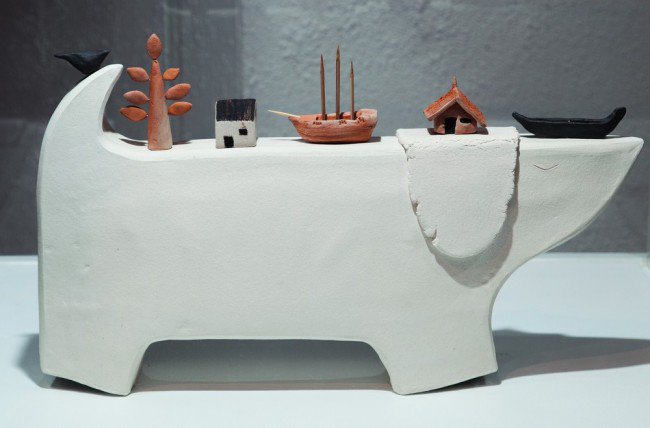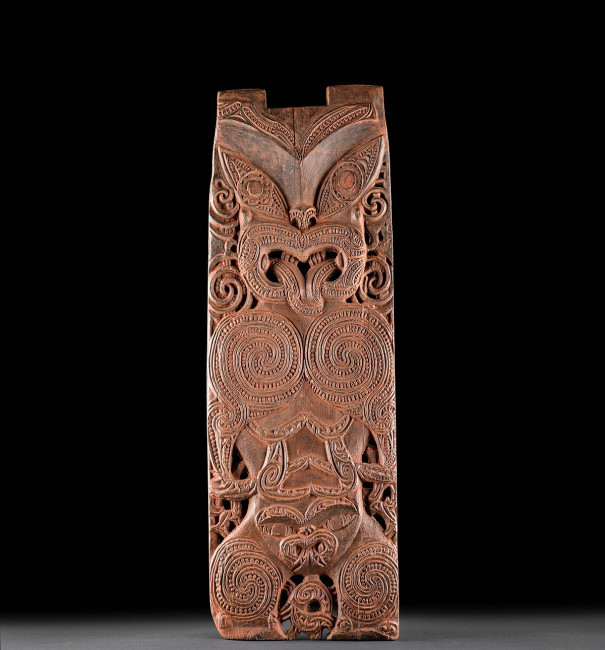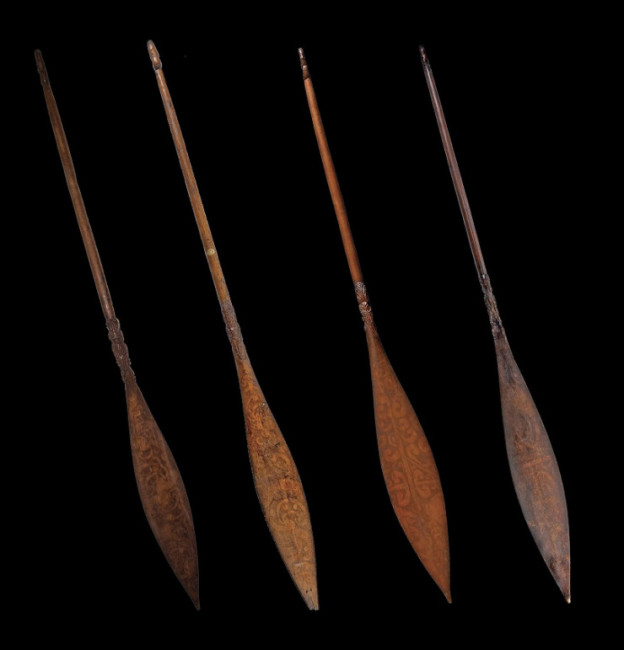Whai ā-matawā nei, tīmata i runga i te taha mauī
Patu ōnewa weapon
Ōnewa Stone
He pērā anō i te mere pounamu, i te patu parāoa, hāpaitia ai hei poro i te upoko hoariri, nā te aneane o tōna ate, o tōna rau. He taonga rangatira tēnei ki te Māori. Mārakerake ana te kite atu i te tohungatanga o ngā mahi, i te ringarehe o tuakaihau. Inā hoki, whā tekau ngā patu parāhe i waihangatia i runga anō i te hiahia ō Joseph Banks hei taonga tauhokohoko. Kei tēnei whakakitenga e whakaatuhia ana tētahi o aua patu parāhe.
Patu ōnewa, mere pounamu and patu parāoa were generally used for decapitation because of their very sharp ends. They were highly regarded by Māori and on ceremonial occasions were used as a chief’s sceptre. This patu ōnewa gives an indication of the inherent artistry and understanding of natural form so characteristic of early Māori workmanship. Because he understood the high regard in which this type of club held, Joseph Banks had forty of them cast in brass. One of the brass patu is on display in this exhibition.
On loan from Cambridge Museum of Archaeology and Anthropology D1914.56
Kotiate weapon
Rākau Wood
He mea hanga tēnei taonga o te riri ki te parāoa, ki te rākau mārō rānei, pēnei i tēnei. He upoko-hou, he mea whakairo, he tohu kaitieki, hei hāpai i te riri āpititū. Ko te kakau mā te ringa o te toa e tūrourou e whai kuhunga ai, e rongo ai te ito i te reka o te rau, o te ate-runga, o te ate-tau rānei o te kotiate. Ko ngā matarua hei koti i te ate o te hoariri, inā hoki tēnei karangatanga ingoa te koti-ate.
This type of patu is made either from whalebone or, like this one, from very hard wood. The upoko-hou on the butt of the handle (kakau) is an example of early carving, usually of a deity or protector. This type of weapon was used in close-range encounters, the owner looking for the opportunity to strike with the ate-runga (upper blade) or the ate-tau (base blade), or to deliver a sharp jab with the top of the kotiate (rau). The two notches (matarua) were used to sever an opponent’s liver, hence the name ‘koti-ate’.
On loan from Cambridge Museum of Archaeology and Anthropology D1914.60
Wahaika weapon
Rākau Wood
He ingoa karangatanga anō tō tēnei tū patu, he patu ngungurahu. He mea hanga ki te parāoa, ki te rākau mārō rānei, pēnei i tēnei waha-ika. E whai tikanga ai i te whawhai āpititū. E rua ngā tohu whakairo, he poukaiora kei te tapa raro o te kape, he upoko-hou kei te pito o te kakau me kore e hinga te ika i te ati. Hāpaitia ai tēnei tū patu hei poka, hei turupana rānei. Me kore ake te waha o te ika.
Patu wahaika, also known as a patu ngungurahu were made from whalebone or very hard wood, and were most useful for fighting at close quarters (āpititū). The carved figure below the inner crescent is usually a deity or protector for the user and is called a poukaiora. The figure on the butt facing away from the hand is another deity to aid the dispatch of one’s enemy. The wahaika could be used for thrusting and striking in various ways. Waha-ika refers to its hook-like shape.
On loan from Cambridge Museum of Archaeology and Anthropology, D1914.58
Patu Parāoa weapon
Parāoa Whalebone
Ko te patu parāoa nei, e pararahi ana tētahi papa, e paku tāwhana ana tētahi. Ko tōna uruuru mata areare, he ate mata turupana, he rau mata whāngai-pō. He pērā anō i te kāhui patu, he pūare mā te tau, he reke kua whakaawaawatia, e pai ai te turupana whakamuri i te upoko hoariri hei te riri āpititū. Ko te momo parāoa nei i monoa nuitia nā tōna mana, nā tōna rarahi, me te aha, i nanao atu taua huatau hei tohu pakanga, nā rā, ko ‘Te koanga umu tohorā’.
This patu retains the natural form of the bone with a flat surface on one side and a slight curve on the other. The elongated blade with a solid striking edge is the ate and the top jabbing edge is the rau. Like other patu it has a pūare (hole) for the tau (wrist cord), and the reke (butt end) has grooves, effective up close in a reverse strike to the head. The parāoa (sperm whale) was admired for its power and size and was referred to in warfare terminology, for instance ‘Te koanga umu tohorā’, meaning to dissect the whale for cooking.
On loan from Cambridge Museum of Archaeology and Anthropology, D1914.57
Wahaika weapon
Parāoa Whalebone
He mea hanga tēnei wahaika ki te parāoa. I whai tikanga ai i te riri āpititū, inā hoki he hangariki tēnei momo wahaika. Kua kore he poukaiora, heoi anō he kōtuke kei te tapa raro o te waha. Kua kore hoki he manaia i te upoko-hou, heoi anō he pūare mā te tau. He rerekē anō tēnei momo wahaika i ngā wahaika o naianei, inā hoki, koia nei te orokohanganga o tēnei hanga, tōmua i ngā whao rino nā te uaua o te parāoa.
This patu wahaika is made from whalebone. Its small size indicates that it was most useful in close range attacks (whawhai apititū). It has no carved poukaiora (guardian or deity figure) which are usually carved near the crescent, however there is a protrusion maintaining the waka-ika shape. It has no manaia (guardian figure) on the upoko-hou (butt end), however there is a hole for the tau (wrist cord). This simple whalebone wakaika is an example of the original form before the introduction of steel chisels allowed more complex surface decoration.
On loan from Cambridge Museum of Archaeology and Anthropology, D1914.59
Tū te Whaihanga Showcase 13
Patu Parāhe Brass patu
Tū te Whaihanga Showcase 11
Kōauau flute Paepae hamuti latrine Turuturu weaving peg Waka huia treasure box
Hamuera by Erena Koopu
Hamuera by Erena Koopu, 2018 Acrylic and graphite on canvas, 710mm diameter This work by Erena Koopu was part of the exhibition Hei ō Mō Apanui | Iwi Sustenance held at Tairāwhiti Museum in 2018 and purchased by the Friends of Tairāwhiti Museum for the collection. He waiata a ringa (an action song) Performed by Te Kapa Haka o Te Whānau a Apanui at Te Matatini in the year 2005 in Palmerston North. Nō te tau 2004 ka whakaturehia e te kāwanatanga te pire takutai moana, e riro ai te taitara o te papa moana, tōna ritenga, he muru whenua. I taua tau rā, ko Tāriana Tūria te wahine toa o Reipa kāore i tautokona taua pire, ā, ko ētahi atu o ana hoa mema Māori, i tautoko tonu. He waiata-ā-ringa tēnei e kōrero ana ki aua mema rā, kia aro ki ngā tohutohu a ngā poropiti Māori, kei reira te māramatanga e noho ana. In 2004 the Government passed the controversial Foreshore and Seabed Bill, which transferred title to the crown, and in itself is a form of modern day confiscation. In that same year, Tāriana Tūria, Māori MP of Labour crossed the floor, while the rest of her Māori colleagues remained seated. This action song speaks to those seated members, and urges them to remember the lessons of past Māori prophets, as clarity must resides in their messages.
Ambrotype, possibly of Lucy and her daughter Ida Tiffen
The museum is offered many interesting items for the collection over the course of the year. Often they are seemingly ordinary, everyday objects, but what makes each of them special and worthy of collecting is the wonderful stories they can tell us about our region’s history. This wicker basket is certainly one such object. This basket was used by William Hamilton (known as Ham) Hannah (b. 1920, d.1967) to deliver bread for Walter Findlay’s Bakery in the 1930s. Ham would have delivered bread around Gisborne by horse and cart. A few people out there may remember having bread delivered by him, perhaps using this basket! Ham served as a Driver in the Army Service Corps in the Second World War and continued to work as a driver when he returned to Gisborne after the war. In the 1960s, he was the Custodian at Churchill Park. He was married to Sarah (Sadie) and they had four children. We would like to thank Julie Hannah for gifting her father-in-law’s breadbasket to the museum.
Ham and two of his four children, Kevin (left) and Gareth (right), posing in the basket in the garden of the family’s home.
Walter Findlay’s advert, The Gisborne Herald, 20 October 1941
Tū te Whaihanga Showcase 3
Tīheru/Tata bailer Matau fishhook
Tū te Whaihanga Showcase 8
Mētara Koroneihana a Hōri III George III Coronation medalet
Tū te Whaihanga Showcase 6
Kaitaka cloak
Tū te Whaihanga Showcase 1
Pouwhenua weapon Tewhatewha weapon Taiaha weapon
Tū te Whaihanga Showcase 9
Tātua belt Kahu kurī dog-skin cloak
Weight on the back of Te Kuri a Paoa by Peggy Ericson
The museum is offered many interesting items for the collection over the course of the year. Often they are seemingly ordinary, everyday objects, but what makes each of them special and worthy of collecting is the wonderful stories they can tell us about our region’s history. This wicker basket is certainly one such object. This basket was used by William Hamilton (known as Ham) Hannah (b. 1920, d.1967) to deliver bread for Walter Findlay’s Bakery in the 1930s. Ham would have delivered bread around Gisborne by horse and cart. A few people out there may remember having bread delivered by him, perhaps using this basket! Ham served as a Driver in the Army Service Corps in the Second World War and continued to work as a driver when he returned to Gisborne after the war. In the 1960s, he was the Custodian at Churchill Park. He was married to Sarah (Sadie) and they had four children. We would like to thank Julie Hannah for gifting her father-in-law’s breadbasket to the museum.
Ham and two of his four children, Kevin (left) and Gareth (right), posing in the basket in the garden of the family’s home.
Walter Findlay’s advert, The Gisborne Herald, 20 October 1941
Tū te Whaihanga Showcase 12
Te Pou o Hinematioro
Tū te Whaihanga Showcase 5 and 7
Hoe paddles
The museum’s collections are always growing and on this page we share some of the highlights. Our thanks to the donors for their support.
Donating to the collection
Visit our Donations page for more information.
Research and access
Researchers can view collections that are not on display by making an appointment with the Museum Collection Manager. Staff can also take small group tours through the collection storage facilities by appointment. Please note that staff are not always available immediately and it is advisable to make arrangements as far in advance as possible, particularly if you are only visiting Gisborne for a short period.
Researchers who are unable to visit in person can make their enquiry by email, letter or telephone
